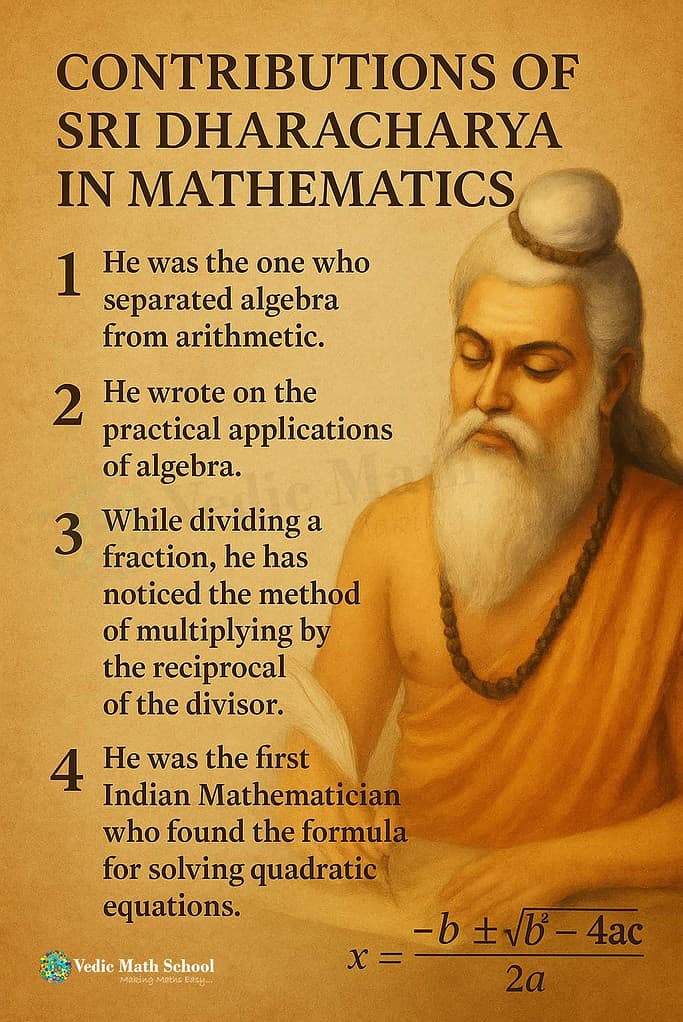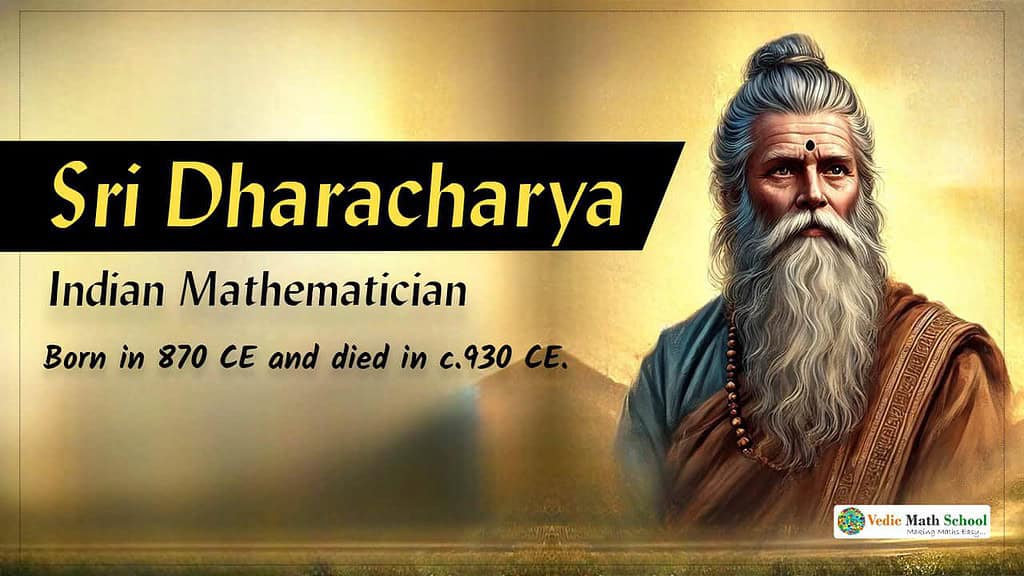Hello and Welcome! Today, let’s explore the legacy of Sri Dharacharya, the Indian Mathematician, Sanskrit Pandit and Philosopher. He gave the world the famous quadratic formula—yes, the one still used today! Dive in to know more about life and Mathematical contributions of Sridharacharya.
Who was Sridharacharya?
Sri Dharacharya was an Indian Mathematician who was born in 870 CE and died in c. 930 CE. Apart from being a Mathematician, he was also a Philosopher and Sanskrit pandit. He was born in Bhuriśreṣṭi which is currently known as Hugli.
He was born to Baladevācārya and Acchoka Bai who were Sanskrit pandit and philosopher too. Sridharacharya, who initially followed Shaivism as a devotee of Lord Shiva, later adopted Jainism.
This extensive work, titled Navashati, meaning “nine hundred verses,” is known through references in Makshibhatta’s commentary on Siddhantsekhara by Shripati.
Sridharacharya Books
He is credited with authoring two important works on mathematics: Trisatika, also referred to as Patiganitasara, and Patiganita, both focused on arithmetic. Additionally, Sridharacharya is believed to have composed a significant text on algebra, now considered lost. Sri Dharacharya has written more than 5 treatises:
1. Pāṭīgaṇita
- Bṛhatpati (“Greater Pāṭi”)
- Navasatī (900 Verses)
Another notable work by Sridharacharya, Patiganita, also centers around arithmetic concepts. The first work, Pāṭīgaṇita—also known as Bṛhat-Pāṭi (“Greater Pāṭi”) and Navaśatī (“Containing 900”)—provided a comprehensive overview of the practical mathematics of its era, particularly focusing on arithmetic and mensuration (the branch of geometry dealing with measurements of length, area, and volume).
Although the original text is believed to have comprised 900 verses, only 251 have survived, and several topics listed in its table of contents are now missing.
2. Trisatika
Trisatika, also called second Patiganitasara, is an important mathematical text authored by the Indian mathematician Sridharacharya. This work primarily focuses on arithmetic and mensuration. It is popularly known as the “book of 300 slokas” due to its composition of 300 verses.
Trisatika discusses a wide range of mathematical topics, including basic counting, measurement systems, natural numbers, multiplication and division, the concept of zero, squares and cubes, fractions, the rule of three, interest calculation, partnership problems, and mensuration techniques.
3. Bījaganita
Sridharacharya also composed a treatise on algebra known as Bījagaṇita, which is now lost. However, excerpts from it are preserved through citations by later mathematicians. Additionally, some scholars suggest that he might have been the author of another mathematical text titled Gaṇita-pan̄caviṁśī.
In summary, in his books, he discusses the counting of numbers, fraction, joint business or partnership, division, squares, cubes, natural number, zero, interest-calculation, rule of three, measures, multiplication, and mensuration (the main part of geometry which deals with sizes, lengths, areas, and volumes).
Just like the other Ancient Indian Mathematicians like Aryabhatta, Baudhayana, Varahamihira, he too has contributed in mathematics which is mentioned below. History gave us pioneers like —Sri Dharacharya, now we must continue their legacy with purpose.
Are you Interested in Vedic Maths Classes?
At Vedic Maths School, we bridge tradition with tech to empower learners of all ages. Our Vedic Maths learning and Abacus courses for school students and teachers available in both online and offline mode ensures no one is left behind in grabbing concepts of Maths. Explore Our Variety of Courses Now!
- Vedic Mathematics Beginner to Advance Complete Course ( Live Class)
- Vedic Maths Teachers Training Program
- Introduction To Vedic Maths [ Beginner Level]
Sridharacharya Contribution in Mathematics
- He was the one who separated algebra from arithmetic.
- He gave an explanation on the zero. He addressed, “If zero is added to any number, the sum is the same number; if zero is multiplied by any number, the product is zero; if zero is subtracted from any number, the number remains unchanged”.
- He wrote on the practical applications of algebra.
- While dividing a fraction, he has noticed that out the method of multiplying the fraction by the reciprocal of the divisor.
- He was the first Indian Mathematician who found the formula for solving quadratic equations.
Brigham Young University has prepared a presentation on Indian Mathematicians where they state that Sri Dharacharya along with other Mathematicians like Mahavira and Brahmagupta belong to Imperials Gupta.

FAQ
Few of the book which is written by Sri Dharacharya are Bījaganita, Bṛhatpati, Navasatī, Pāṭīgaṇita, Trisatika (300)
The Sridharacharya Formula, also known as the quadratic formula or Sridharacharya Method, is a standard technique used to solve quadratic equations of the form ax² + bx + c = 0, where a ≠ 0. The formula is expressed as:
x = (-b ± √(b² – 4ac)) / 2a
The Sridharacharya Formula, also known as the quadratic formula or Sridharacharya Method, is a standard technique used to solve quadratic equations of the form ax² + bx + c = 0, where a ≠ 0. The formula is expressed as:
Sri Dharacharya was the mathematician who is especially well-known for developing a technique to solve quadratic equations, a method that later came to be known as the Sridharacharya Formula.
Sri Dharacharya, also known as sridhara, died in 930 CE. He was not only a Mathematician but also a Philosopher and Sanskrit pandit.



Sir, Asalam.o.alikum kya ap mujy maths tricks sikha saktay ha?